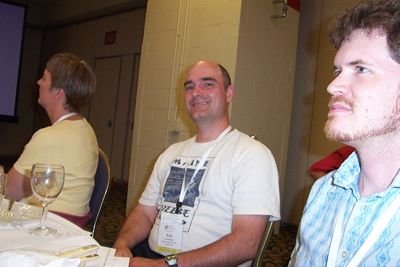
8:30am — Is Selling Up Selling Out? was a discussion about the choices cheesemakers have for selling their product, from the small retailer to Whole Foods to Costco. Steve Jones of Steve’s Cheeses in Portland, OR represented the small retailer, and he explained how his store’s motto is: “Buy less, come back more often!” He told us that he’s committed to cutting all cheeses to order and turning over his stock every 10 days whenever possible. Cathy Strange, the worldwide cheese buyer for Whole Foods, gave a ringing defense of Whole Foods commitment to buying locally and directly from producers whenever possible. She said that although that Whole Foods’ volume doesn’t permit them to cut-to-order all of their cheese, they will when asked. Then Costco representative Dave Dugan described the Costco chain and how they sell their cheeses (which he described as a “high velocity item”), emphasizing the “by the pallet” aspect of their distribution systems, and that they try to limit their total cheese SKUs to about sixty (vs. about 250 cheeses that WF carries). It was interesting to hear that Whole Foods would decide NOT to carry a cheese that was being sold at a large “discounter” — specifically WalMart — but would be willing to refer customers to local small retailers for cheeses that they didn’t carry.
10:15pm — Flavor and Ripening Cheese Cultures 2: with Stevens Funk and Dave Potter was a “continuation” of a talk given at the Burlington, VT conference in 2007 which introduced the concept of Adjunct Cultures to cheesemaking: adding cultures solely for their enzymatic properties, rather than for that plus their expressed properties. An example would be to add a Pc mold to a cheddar cheese that would be aged in cryovac bags. The Pc needs oxygen to grow, and lacking that would never create a bloomy rind on the cheddar before dying as the cheese aged. However, the Pc cells would still contribute their internal enzymes to the cheese after dying, which would be different from the normal mix of mesophilic culture enzymes, and thus create different compounds and flavors during aging than a cheddar would without the adjunct culture. Given the hundreds of strains of different moulds and cultures used in cheesemaking, each with a slightly different affect on cheeses during aging, there are many new possibilities for flavor development in aged cheeses (fresh cheeses, which primarily depend on active cultures for flavors would not be as affected by Adjunct Cultures).

After lunch I walked up Michigan Ave. to Milennium Park, at the top of Grant Park, which is a newly designed and constructed sculpture park with lots of new public amenities. One of them is a very cool (literally!) plaza with two glass brick towers/sculptures/fountains that contain computer controled LEDs that will display video images. Pictured above is one of the hundreds of faces of ordinary Chicagoans that the artist filmed for the series. Each face displays for five minutes with various expressions, ending with puckered lips at the same time that a jet of water shoots out of the tower at the spot of the video lips. Meanwhile water continuously cascades down the towers, making it a great place to cool off in the hot Chicago summer.
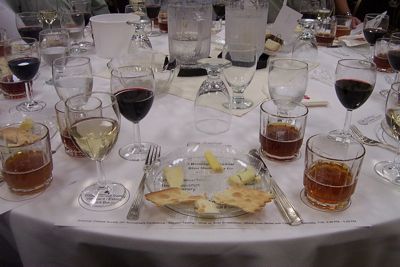
3:30pm — Wine vs. Beer Smackdown: Which Goes Better With Cheese? pitted Greg Hall from Goose Island Brewing Co. (Chicago) against a wine distributor filling in for the sommellier from Fahrenheit Restaurant pairing their products with four different cheeses to explore what works and try to find new or unconventional combinations. The four cheeses were an aged cheddar (Bleu Mont Dairy Co. Bandaged Cheddar), a blue cheese (Rogue Creamery’s Organzola), a “stinky” rind ripened cheese (Jasper Hill Farm’s Winnimere), and a sheep milk cheese (Ocooch Mountain from Hidden Springs Creamery). The only thing that was missing was a fresh goat cheese, but that will have to be at next conference.
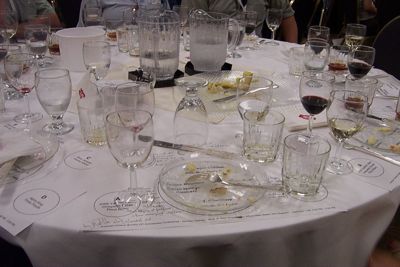
The wine samples were a smooth red wine (Kana Dark Star 2005, a Rhone style blend) because “Cabernet [and other wines with big tannins] is NOT a friend of cheese”; and a light 2006 Yamhill Valley Vineyards Estate Pinot Blanc. The beers were a very malty and lightly hopped Belgian-style ale from Goose Island called “Pere Jacques”; and a very hoppy pale ale style called “Alpha King” from Three Floyds brewery. Greg won the coin toss, so we started with the beers first: the smooth malty-fruity Belgian-style ale went really well with most of the cheeses, especially the stinky-gooey Winnimere (in fact this was my favorite combo of the whole exercise) that had parallel fruity notes. But the Pere Jacques was equally good with the two aged hard cheeses. The pale ale style beer did not go well with most of the cheeses since the bitterness of the hops highlighted the bitterness in the aged cheese, and it fought they stinky-fruit of the Winnimere. It was only OK with the Organzola, where as the Pinot Blanc was pretty good with the blue cheese. It had a pronounced raspberry honey aroma but a dry citrus taste, and it also matched well with the two hard cheese. It also fought with the Winnimere. The red wine had cherry and cocoa puree tones on top of a very smooth finish, a very nice wine, but strangely didn’t pair well with any of the offerings, though best with the blue. I would have thought that the bandaged cheddar would have been a natural pairing, but not so — it was kind of like oil and water in my mouth. Maybe a richer less-sharp blue, like a Roquefort, might “explode in the mouth” the way the wine distributer described happening with the best pairings.

5:30pm — The 2008 Festival of Cheese is the culmination of each ACS conference, and lately, as the numbers of competition entries has exploded, the festival has become an unbelievable exhibit of American cheese, some of which has been labeled “world class” by chefs and food writers, and all of which is at least pretty good. And you *could* taste all of it — all 1135 entries, plus a few other donated cheeses.
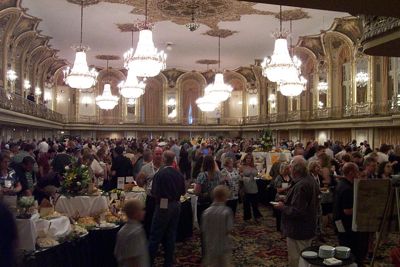
ACS 2008 Festival of Cheese in the Hilton Chicago ballroom
This year’s festival FILLED the Chicago Hilton ballroom. Each category of cheese took several tables to hold them. It’s an amazing feat that the ACS and it’s volunteers pull off, and this year’s production was just as impressive as last year, including a cheese sculpture of the Chicago Skyline. (If you’re interested to learn more about how it was put together, you can read my Dad’s blog entry about it here.)
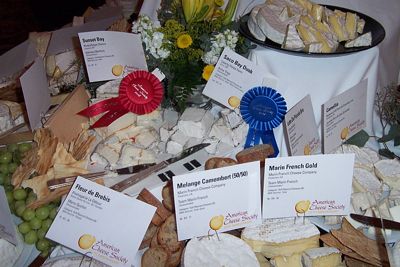
Liberty Fields Saco Bay Mist -- First Prize Winner!
This was my second FoC, and instead of pinballing from table to table (which I did last year, filling up on buttered bread right at the beginning!), I targeted two tables to focus on: washed rind cheeses, and blue cheeses (of course). I also made sure we got there early enough to get a taste of the Best In Show samples: Snow White Goat Cheddar by Carr Valley Cheese. It was very good, with a nice firm but not dry texture, but it wasn’t bounds beyond some of the very good bandaged and clothbound aged cheddars I’d been tasting through the conference. I wanted to focus on the washed-rind table because there is a proliferation of interesting types in this category, and it seems like there’s a lot of imagination behind their creation. This year I really enjoyed the Winnimere, a super-gooey spoon served cheese packaged like a Vacherin Mont d’Or, wrapped with a spruce band (which I also sampled during the “Smackdown” described above). It featured all the stinky aromas and fruity flavors along with that ultra-gooey texture and no “off-flavors” at all. Certainly it’s not for everyone, but I really enjoyed it. As for the blue table, two Rogue River Creamery blues took first and second place this year, same as last year, but I was struck by how many “sharp” blue cheeses are being made, which is a very different flavor profile than I’m going for in my cheeses because it tends to dominate in the back of the throat and in the nose when you’re eating it
Still, despite targeting my tasting, and making sure to take breaks by getting pictures of some of the Maine award winners (as above), I was “cheesed out” after about an hour. My Dad had spent all day cutting cheeses, so it was amazing that he lasted that long. We happily floated out of the ornate Hilton lobby, and carefully strolled down the sidewalk and then around the corner to our hotel where we happily watched the Cubs on TV and prepared to check-out first thing the next morning. After all, we had to stop at the Cheese Sale before leaving town!